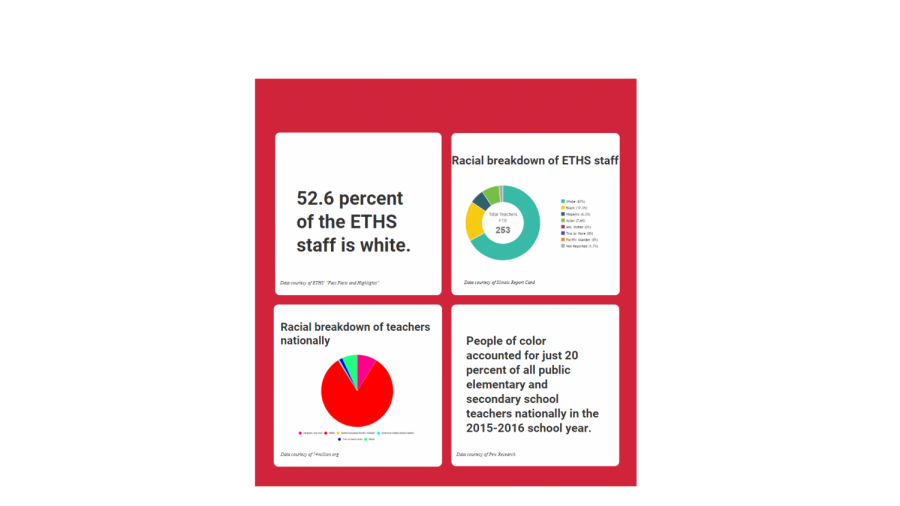Students weigh in on staff representation at ETHS
August 21, 2019
There is only one thing that ETHS prides itself on more than orange and blue: their racial demographics. From pamphlets to websites and public forums, the ETHS administration rarely fails to mention how important diversity is to the school community. While the administration remains prideful, students question the amount of representation in curriculum classes.
“If your student population is so diverse, why not hire staff members that emulate that?” senior Kennedy Freeman says. “I feel like my learning experience would be different if I had more teachers that look like me.”
While the majority of the ETHS employees are made up of white people (52.6 percent to be exact), that is not to say that there’s no diversity at all. According to the school’s “Fast Facts & Highlights,” the employees at ETHS are made up of 0.17 percent American Indian, 3.69 percent Asian, 34.84 percent Black/African American, 7.2 percent Latinx/Hispanic, and two or more races holding 0.81 percent.
Despite these facts, many students can still count the number of nonwhite teachers they’ve had on one hand- or not at all.
“I’ve never had an English teacher of color in my whole life. It’s a subject that I really enjoy, but it’s a tad bit frustrating never having that communal feeling in those spaces,” senior Seth Shimelfarb-Wells says.
Students note that having a teacher that reflects them racially creates feelings of safety and comfort in the classroom.
“I found myself opening up to them [teachers] more than any of the other teachers I had because I knew they could relate to the things I had to say,” senior Shilae Hudson says. “They pushed me harder than any other teacher and really helped me find my voice as a POC (person of color).”
Many other students with differing identities share similar stories and positive experiences with teachers whom they resemble.
“Having teachers that look like you in the sense of race, ethnicity, gender, age and so forth tends to make more meaningful student-teacher bonds, as the teacher is someone a student can not only relate to, but allows the student to see someone like them in a role that’s been so homogenous for so long,” senior Izequiel Freitas says.
On the contrary, lack of POC representation in teaching staff has affected the learning and motivation of some.
“Being surrounded by teachers whom I see no resemblance in discourages me from furthering my educational journey and makes me wonder what role black people play in society,” recent ETHS Alum Hailey Etienne says.
Lack of representation in classes isn’t new. Even before their time at ETHS, students have existed in spaces where the authority figure doesn’t reflect their background or interests.
“The only teachers I’ve had that looked like me were my Chinese teachers in grade school,” senior Audrey Kermgard says. “Looking back it felt like Asian women were only meant to teach their native languages, never math or science.”
Despite the forty (approximately) academic teachers from kindergarten to now, I can only think of six black teachers that I’ve had class and gained knowledge from. Twelve years of being surrounded by, but never immersed with, educators who share my background has allowed me to realize how crucial teacher representation is in my life.
In my learning experience, educators are in a position where they possess the ability to provide so much more than academic knowledge. They can and do serve as mentors, supporters, and most importantly, role models.
The presence of non-white teachers is more important than ever, especially with an increase in the population of students of color while over forty percent of public schools in the U.S. still do not have a single teacher of color, according to the National Education Association.
“Having POC [teachers] accessible forces young people to be aware that there’s a reality that’s not attached to popular stereotypes,” Career and Technical education teacher Darlene Gordon says.
According to the Learning Policy Institute, explanations for why there’s lack of POC teachers in core classes can stem from a number of factors: poor working salaries and conditions, inadequate teacher preparation, disproportionate teacher licensure exams and staff displacement .
Nonetheless, representation in staffing can make for a better student experience with learning. The Learning Policy Institute even adds that representation in teaching staff can boost academic performance of students of color, create a positive perception of teachers of color, and increased feeling of care and challenge in their academic courses.
Regardless of fact and opinion, the way the students feel in their learning space is the most important aspect of all.
“Having a teacher to connect with who is also a person of color is like an addition to my family,” Hudson says.









